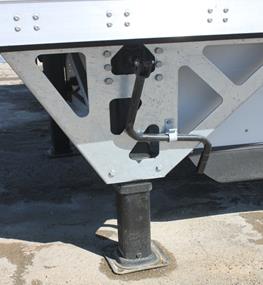
Specs That Reduce Maintenance Headaches
Poorly spec’d trailers can wreak havoc in your fleet.
Let’s face it—trailers take a beating in day-to-day use. If they aren’t built to last, they break down, leading to downtime and, sometimes, damaged cargo.
Specs that reduce maintenance make your trailers damage-resistant and help them endure the rough-and-tumble of over-the-road work.
A well spec’d trailer simplifies maintenance and reduces overall costs. That’s important for any fleet watching its bottom line and concerned with lowering operating costs. So, basically, any fleet.
Why not follow a spec philosophy that supports
- Reduced risk of damage and cost of repairs
- Reduced out-of-service time
- Lower total maintenance cost over the life of the trailer
- Extended maintenance intervals
One large trailer lessor (whose initials are XL) follows such a philosophy. Here’s what it looks like in action:
Dry Van Specs That Reduce Maintenance
Want to reduce damage in the trailer interior?
Spec trailers with composite sidewalls and galvanized steel inner and outer panels. Traditional aluminum sheet-and-post trailers with plywood liners can puncture more easily when hit with a forklift.
Beat the attack on scuffliners
To protect your trailer’s interior even more, install fluted aluminum or galvanized steel scuffliners that can withstand the beating delivered by forklifts, while maintaining maximum width and cubic capacity.
Put floor ratings through the roof
Extra crossmembers on your 53’ trailers increase durability. A trailer built with crossmembers on 10” centers (instead of 12″ centers) increases the floor rating to 24,000 pounds versus 16,000 – 20,000 pounds.
For greater durability, add a floor protection package for the last four feet of the trailer: crossmembers on 8” centers and at least a 24” threshold plate.
Eliminate suspense from slider systems
An air-assisted slider and pin-lock on your suspension systems can help reduce physical strain on the operator and damage to the trailer. With the push of a button, a driver can release and engage the slider pins to re-position the suspension.
 Get lights that keep you beaming
Get lights that keep you beaming
LED fixtures with anti-theft grommets last a long time. You get two benefits with LED lighting. First, low-maintenance LED lights are less susceptible to the shock and vibration damage that are a common cause of incandescent light failure. Second, their bright output increases safety for your drivers.

Make a safe landing
Equip your landing gear with long-life grease and an internal grease sleeve.
This feature provides a fresh coat of grease each time the legs are extended, eliminating maintenance for the first five years of a trailer’s life.
Curb corrosion damage
Help your trailer’s undercarriage, rear frame and underride guard resist rust. Use galvanized or stainless steel components to provide better protection against magnesium chloride, a common road de-icer.
Cut the friction between you and your brakes
Extended service brake linings are 1/8” thicker—adding life to your linings and about 20,000 more miles between brake jobs.
Reefer Specs That Reduce Maintenance
Spot the warning signs
With a high visibility status light and fuel sensor, your driver can spot a warning signal from the cab’s mirror when a reefer tank is running low on fuel. So the driver can address the issue before cargo is harmed or the reefer unit is damaged. These specs can help prevent battery, starter and alternator failures that can occur when units run out of fuel—which helps you avoid a big repair bill.
Guard the walls
A strong thermoplastic interior lining can double puncture resistance, which reduces the risk of damage from forklifts. And a thermoplastic lining reduces the weight of the trailer, which means you can haul more cargo in it. That’s quite a protection package.
There’s no question that certain specs improve the life, maintenance and operability of a trailer. Our experience shows that the best approach a fleet can take is to develop a strategy that matches specs and costs with the economic life of its trailers.
- FleetOwner reports that certain specs lower maintenance costs without lessening a trailer’s strength and durability. (You’ll have to log in or register to read this article.)
- You might like to see some dry van specs.
- Reefer specs might be helpful to you.
- We didn’t mention them in this post, but you might be interested in flatbed specs, too.
- Of course, you could just rent or lease from XTRA and leave the specs to us!